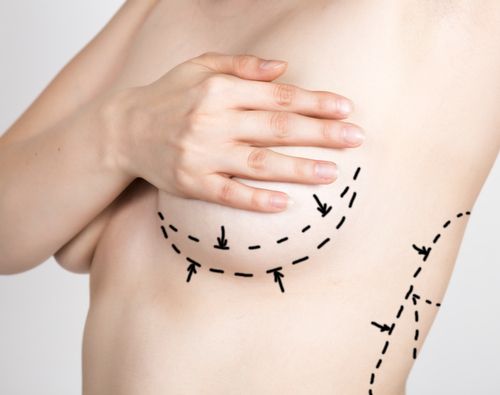
Breast Reduction

Women who have particularly large or heavy breasts can find that they have a negative impact on their day to day lives. They can prevent women from taking part in certain sports, cause back pain and breathing problems, and create low self-esteem and self-consciousness. However there is a solution.
Breast reduction surgery, otherwise known as reduction mammaplasty, is a cosmetic surgery procedure that is designed to augment the breasts in order to make them smaller, lighter and firmer. Many women who suffer from symptoms associated with overly large breasts are choosing to have reduction surgery, and numbers are still increasing.
The majority of women who undergo breast reduction surgery report feeling physical relief as well as an increase in self-esteem and body confidence.
Reasons for wanting a breast reduction
There are many reasons as to why you might desire a breast reduction, but some of the most commonly reported reasons include:
- Feeling that your breasts are out of proportion to the rest of your body
- Causing physical pain including back, shoulder and neck pain
- Soreness and infection under the breasts
- To remain an active lifestyle
- To improve confidence and self esteem
- To improve the fit of clothing

Types of Breast Reduction
There are different types of breast reduction available and your cosmetic surgeon will be able to advise you which is right for your circumstances and desired result.
Concentric (Doughnut) Breast Reduction
This type of reduction is typically seen in ‘smaller’ large breasts with less sagging. Circular incisions are made around the areola (in the shape of a doughnut!), excess breast tissue is removed, and then the areola and nipple are moved upwards and into their new position.
The key benefit to this type of reduction is that the scarring is around the areola, making it less noticeable. However your surgeon may be limited as to how much breast tissue he can remove.
Anchor Breast Reduction
This is the most common type of breast reduction procedure and gets its name from the anchor-shaped incision that is made. It begins above the areola and extends downwards on either side of the areola and out in a curve towards the side of each breast. Once the incision is made, excess breast tissue and skin is removed and the areola and nipple are moved upwards and into their new position. The skin is then pulled together, creating the new shape of the breast.
This reduction requires more stitching which follows the anchor shape, around the areola, downwards to the bottom of the breast and then along the crease where the breast meets the chest.
Before your Surgery
Stop smoking. Smoking is not good for your general health and can slow down healing after your procedure.
Avoid any medication containing aspirin and non-steroidal anti-inflammatory drugs for at least two weeks before your surgery as they increase the risk of bleeding.
If you are overweight then you should try and lose weight before your surgery. This will allow your surgeon to remove more loose skin and achieve a better result. Losing weight after a breast lift can make the skin sag again, making the initial procedure worthless.
You will need to purchase a sports bra to take with you to the hospital. Your surgeon will be able to advise you on the correct size to get.
Breast reduction surgery requires a general anaesthetic and you will be required to have a pre-op medical approximately two weeks before your procedure.
Your Surgery
On the day of your operation your surgeon will mark up your breasts with marker pen ahead of your anaesthetic.
Once you are asleep you can expect your surgery to take around two to two and a half hours, depending on whether you are combining your reduction with a breast lift too. A small incision will be made in to the natural crease of the breast, into which the implant will be inserted. The wound will then be closed using dissolvable stitches.
When you come round from the anaesthetic you will be in moderate discomfort; and your nurse will prescribe you pain relief to help alleviate this problem. You will have a drainage tube put into each breast, which will then be bandaged with your sports bra fitted over the dressings. The drainage tubes will normally stay in for the duration of your stay in hospital, usually one or two nights.
Complications
As with any surgery, there is a small risk of complications during a breast reduction. These include but are not limited to:
- Reaction to anaesthesia
- Bleeding, hematoma, bruising
- Infection
- Changes in skin sensation due to nerve injury
- Scarring
- Skin necrosis (loss of skin from tissue death)
- Deep vein thrombosis, cardiac and pulmonary complications
- Breast asymmetry or contour/shape irregularities
- Mammograms post-surgery may be more complicated
- You may struggle to breast feed after surgery
Recovery
Your surgeon will probably advise you to take up to two weeks off work following your breast reduction, giving you time to heal properly. Your stitches are usually removed around a week post-surgery, but you will need to remain wearing a post-surgery bra/sports bra for at least 6 to 12 weeks after your operation.
All breast reduction surgery leaves scarring, but with proper care and time these will fade to become minimal. Dr. Metzinger will be able to advise you what you can do to look after your scars.
Your surgeon will also make scheduled appointments with you to check how you are healing and to ensure your procedure has been a success.
If you have any questions or concerns during your recovery, contact Aesthetic Surgical Associates who will be happy to assist you.
